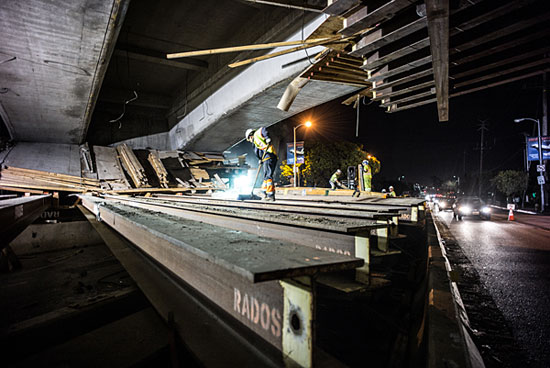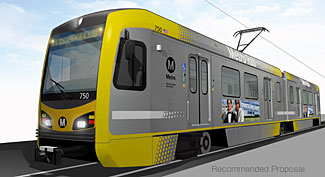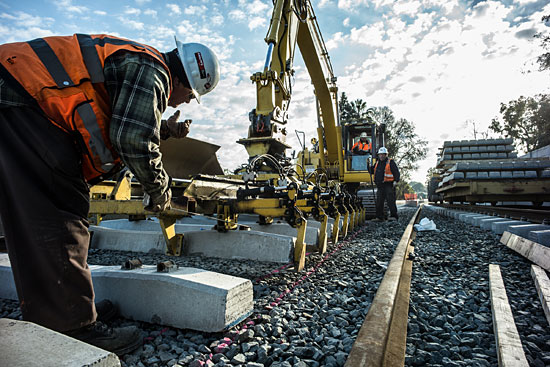Looming train shortage at Metro
March 12, 2014
As two Los Angeles light rail lines race toward completion, there’s trouble ahead on the tracks. Unless train car production can be significantly accelerated, there won’t be enough vehicles to serve both new lines—Phase 2 of the Expo Line to Santa Monica and the Gold Line Foothill Extension to Azusa—if they open as scheduled in late 2015 and early 2016 respectively.
Metro is so concerned about the problem that it’s dispatching a delegation to the manufacturer’s headquarters in Japan later this month in hopes of finding a way to speed up production—a tall order for a company that the agency acknowledges is on track with the aggressive schedule mutually agreed to under its contract.
So, with a likely initial shortfall of about 50 train cars, the issue presents some tough decisions for Metro, all of which are likely to be unpopular with the traveling public. It could delay the new lines’ openings, operate them with shorter, more crowded trains, offer less frequent service, or redeploy cars from elsewhere in the system, thus spreading the pain more broadly.
The shortage is expected to be most severe in the first months of operation for the two new extensions, with steady improvements coming as new rail cars arrive throughout 2016. But even the prospect of a relatively short-lived disruption has been enough to strain the relationship between Metro, which will operate the lines, and the two construction authorities charged with successfully completing the projects.
Samantha Bricker, chief operating officer for the Exposition Light Rail Construction Authority, expects Expo Phase 2 to be ready for testing in the summer of 2015, which would make it possible for the line—running from Culver City to Santa Monica— to serve the public as early as December, 2015. But she’s worried that the train car shortage could impede that schedule and disappoint passengers looking forward to jumping aboard the westernmost phase of a light rail line that’s already attracting large numbers of riders.
“If these projects are done on time and there are no trains there, the public is going to go nuts,” Bricker predicted.
Metro’s Gold Line Foothill Extension, running from Pasadena to Azusa, is expected to open just two months later. Habib Balian, chief executive officer of the Foothill Construction Authority, said he, too, is worried that his line’s opening will be delayed or marred by diminished service in the early months.
“It’s going to sit there and cobwebs are going to grow until Metro starts service, or they are going to put wimpy service on all the rail lines,” Balian said, referring to the possibility of importing rail cars from elsewhere in the system.
The roots of the problem go back to 2010, when a previous manufacturer, AnsaldoBreda Inc., failed to meet the specifications for an earlier order of Gold Line cars, according to Richard Hunt, who manages Metro’s rail car procurements.
Given the time crunch, Metro’s chief executive officer, Art Leahy, urged Board members to act quickly and, in April, 2012, after a competitive bidding process, the Board awarded a new contract to another company, Kinkisharyo International, LLC. After Kinkisharyo landed the contract, it relocated its U.S. headquarters from Boston to El Segundo and is currently building a facility in Palmdale where the final assembly of the Metro rail cars will take place.
Metro officials say they are confident that Kinkisharyo can deliver, but due to the time lost after parting ways with AnsaldoBreda, the process is now a year behind schedule.
No easy solutions are apparent, but Metro is brainstorming fixes and contingency plans, said Brian Boudreau, an executive officer who oversees major capital projects. All options remain on the table.
On March 27, Metro Board Chair Diane DuBois and Pam O’Connor, chair of the Expo Authority and a member of Metro’s Board of Directors, will join Hunt on a delegation to Kinkisharyo’s headquarters in Osaka, Japan to check on the progress and see if anything else can be done.
Hunt said the agency already has submitted a formal request to Kinkisharyo to speed delivery, but acknowledged that the prospects of that are slim.
Kinkisharyo’s president, Teiji Tani, agreed.
“The schedule that Kinkisharyo International and Metro agreed to was and is very aggressive,” Tani said in an email. “Given the challenges we have been facing, it’s unlikely that the schedule can be accelerated on the initial 78-car order.”
The current contract calls for delivery of 78 light rail vehicles at a price of $299 million, with options for additional cars for Metro’s expanding light rail network that could bring the total value of the contract to $890 million. The agreement includes what Hunt called an “unprecedented” delivery schedule—about twice as fast as normal. Kinkisharyo agreed to deliver the first 78 cars at a rate of 4 per month, beginning in September, 2015. The final installment wouldn’t arrive until January 20, 2017, about a year after the rail lines are expected to open.
Metro’s chief of operations, Debra Johnson, demurred on the question of how big the impact on transit riders could be, but said that “all options have to be assessed.”
“Here we are, stewards of the taxpayers, and we are going to do our due diligence to make sure they are least-impacted,” Johnson said.
Metro’s Board of Directors is scheduled to get a status update on the situation in April, including feedback from the delegation to Japan as well as contingency plans for running the lines without all the cars.
In the meantime, Kinkisharyo officials say they are keeping things moving as fast as possible.
“We are finalizing design, setting up our assembly plant in Palmdale and starting to produce the initial two cars, also known as test cars,” Tani said. “We’ll soon start hiring 100 additional employees for that plant.”
Posted 3/12/14















 405 bridge work causes a stink
405 bridge work causes a stink

